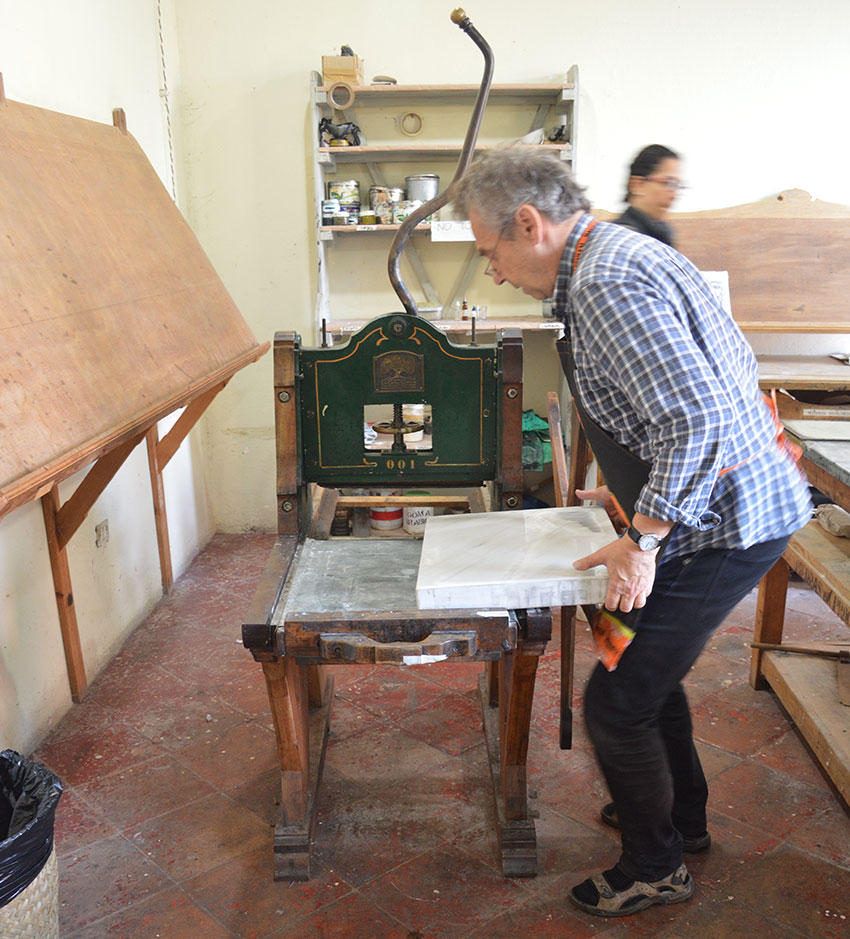Tucked away in the rainforest of northern Veracruz is La Ceiba Gráfica, a restoration and community project dedicated to researching and preserving pre-20th century printing processes.
The first visual cue that a visitor is in the right place is a huge ceiba (kapok) tree in front of an old colonial-era mansion. The second cue are racks of snow-white paper set out in the sun to dry.
The mansion was the center of La Orduña hacienda which, at its height, grew over 6,000 hectares of sugar cane and coffee. Today, most of that land is the municipality of Coatepec, a Pueblo Mágico (Magical Town) near the Veracruz capital of Xalapa.
Now it is the home of La Ceiba Gráfica, a non-profit arts center whose goal is to unite art, ecology, and community involvement to create an institution that is self-sustainable and helps the economically depressed region.
The main activity here is lithography, a printing process using simple chemicals and ink over stone, but it also works in rotogravure, Japanese woodblock printing (moku hanga), book binding, textiles and more.

One of its signature activities is making the fine paper needed for this work. The hacienda’s old garage is the paper-making workshop called the Living Museum of Paper (Museo Vivo del Papel). Here, paper is made completely by hand, using cotton, recycled materials and a Japanese plant called kozo (paper mulberry).
With help from the National Institute of Ecology, the plant is now grown on the hacienda’s remaining hectare of property, and other properties that are rented for its cultivation. La Ceiba not only makes all of the paper it uses, there is a surplus that is sold in Mexico and abroad.
In addition to paper, La Ceiba has other activities that allow it to be almost entirely self-sustaining. One of the organization’s main economic activities is the artistic residency program, in which artists travel to the hacienda to work on projects and/or learn about printing processes.
It has hosted famous Mexican artists such as Francisco Toledo and José Luis Cuevas, and it draws many artists from other countries. La Ceiba also offers classes in all of its craft and artistic activities. It receives support from the state, but that is entirely for the reconstruction and preservation of the hacienda’s house and grounds as a historical site. The mansion’s many rooms are dedicated to workshops, a gallery, a store, guest rooms and a communal kitchen.
Anderson came to Mexico in 1974 from Sweden and began teaching at the Universidad Veracruzana. Tasked with teaching printmaking at the school, he quickly found that such an activity was not practical. He barely had resources to teach, and graduating students would need thousands, maybe millions of pesos to set up their own workshops.
The reason for both problems was the same: artistic printmaking in Mexico is heavily dependent on the importation of all the machinery and supplies from developed countries.

Anderson has since dedicated his life to finding alternative ways to make fine quality and artistic prints in Mexico. He learned how to design and build presses, then searched to find raw materials in the state: marble from Tatalita, silicon from Alvarado, leather from Orizaba, etc.
Over the years, Anderson himself learned every facet of the craft of printing, not just the art. He has cultivated and harvested bark, scooped fibers into box sieves to form sheets of paper, ground pigment for ink, designed and redesigned presses and has done all kinds of carpentry.
Not a fan of capitalism, Anderson believes that in the La Ceiba project he has worked out many of the problems that economic cooperatives can have. “Everything can be resolved without resorting to commercial projects, if only you reflect on how to resolve the challenges of contemporary art.”
La Ceiba has become a model for similar ventures: about 35 organizations in Mexico have adopted its organizational structure and techniques for making equipment or both.
In 2013, it won the sustainable printmaking and community award from the Southern Graphics Council based in the San Francisco Bay Area and holds an annual conference that attracts over 2,000 participants from all over the world.
Leigh Thelmadatter is a regular contributor to Mexico News Daily and writes a weekly culture column that is published every Saturday.
